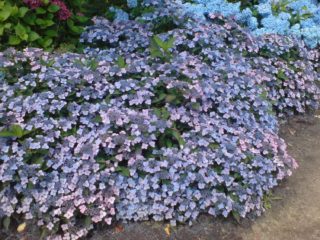Content
Rough hydrangea is a plant with beautiful flowers, belongs to the family of the same name. It is of oriental origin and grows in the wild on the coast of China and Japan. In the 19th century, hydrangea came to Europe, where it immediately fell in love with many garden design lovers.
Description of rough hydrangea
Most species of the Hortensia family are shrubs up to 3 m high and 2 m wide. Some of its representatives have a tree-like shape, in addition, vines are also found among them. Hydrangea bushes have thick branches. They have large inflorescences of a white or lilac hue.
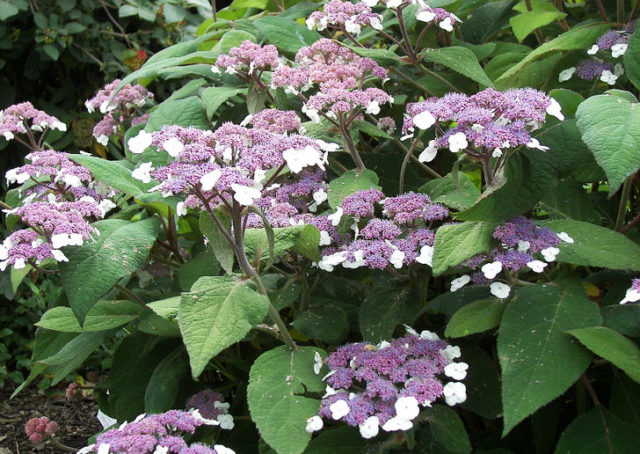
In the middle, they consist of many small flowers, around the perimeter they are surrounded by several large white flowers with four petals.
The leaves can be quite large - up to 35 cm long and 25 cm wide. Their colors change during the season. Young foliage is dark green, velvety. Towards the end of summer, it changes color to dark orange. The root system is powerful, branched.
The plant is very hardy: hydrangea can be grown in difficult conditions and at relatively low temperatures. In temperate climates, it can be cultivated almost everywhere. It blooms in late summer or early autumn.
Varieties of rough hydrangea
Currently, there are several varieties of rough hydrangea. In addition, we are constantly working on getting new ones. The most popular varieties of this culture are considered below.
Macrophile
The height of this hydrangea is 1.5 m. It has rough leaves, covered with fine hairs. Their length reaches 35 cm, width - up to 20 cm. The inflorescences are quite large - in some specimens the diameter reaches 20 cm. Rough Hydrangea Macrophila is shown in the photo below.
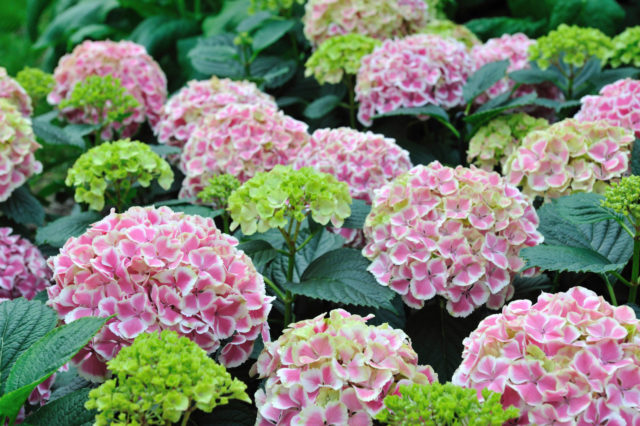
The spherical inflorescences of this variety have a variety of shades, in general, the color of the plant depends on the acidity of the soil.
Sargent
The height of the crop can reach 4 m. It is one of the most popular varieties with velvety leaves. The main feature of this variety is a gradient change in color within one inflorescence and a smooth transition from a lilac shade to pink (and then to blue) over the area of the entire bush. In addition, on some plants, the petals can be either white or have a white edge.
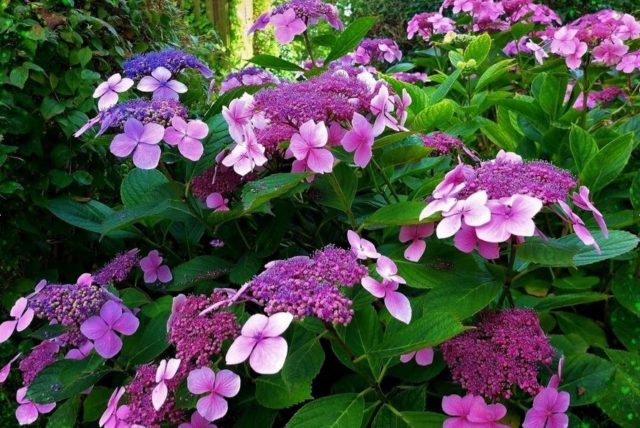
Flowering is quite late and long, it begins in September and lasts until the first frost
Hot Chocolate
The variety introduced relatively recently. It has huge inflorescences - up to 30 cm in diameter.
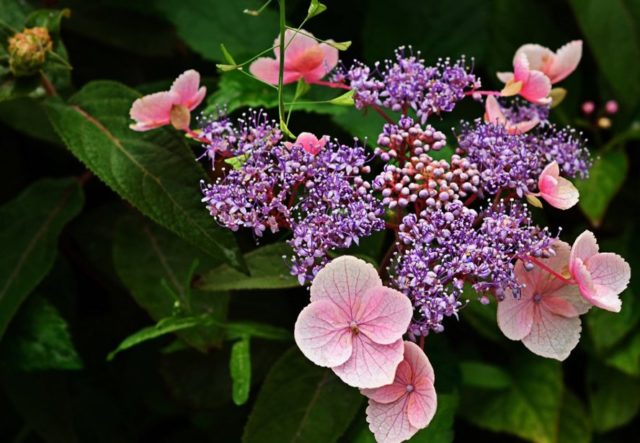
The leaves of this variety also change their color, but, unlike the classic change from green to orange, it has a transition from silver to olive
The color of the shoots also changes over time: as the temperature decreases, they turn red.
Rough hydrangea in landscape design
Rough hydrangea is widely used in landscape design. Large bushes can be used as a monoculture in large areas.From them, you can create dense hedges, use them as curb plants for wide paths.
As a separate design element, rough hydrangea will look beyond any competition, since bright and beautiful flowers attract attention.
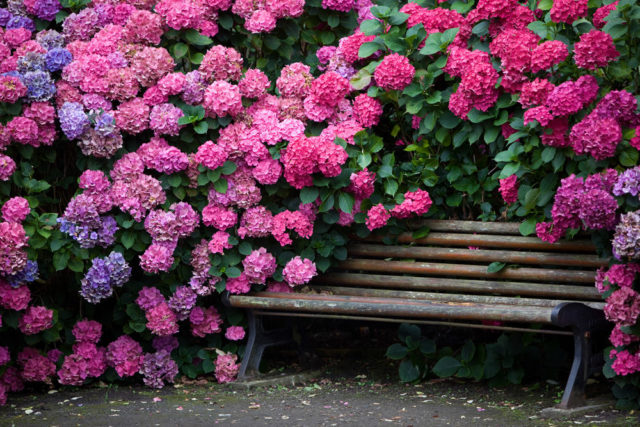
Making a bench with the Macrofila variety is a common use in the landscape of a park area
It is also good to use rough hydrangea as a central element of a large flower bed, surrounded by bushes of bright and large plants, the flowers of which will contrast with it. She looks good surrounded by variegated annuals.
Wintering rough hydrangea
Hydrangea has good winter hardiness, however, at frosts of about -30 ° C, it is recommended to insulate the near-trunk circle in order to protect the plant roots from freezing. Fallen leaves of trees or sawdust can be used as a covering material.
Planting and caring for a rough hydrangea
Planting and caring for a rough hydrangea is not particularly difficult. The only thing that should be given close attention is watering, since the plant needs a lot of moisture.
Selection and preparation of the landing site
An ideal place for a rough hydrangea is an area sheltered from the wind in partial shade. The soil must be nutritious and have a pH level of at least 5.0 (be slightly acidic).
Preliminary preparation of the site for rough hydrangea consists in clearing it of weeds and applying mineral fertilizers (up to 20 g of superphosphate per 1 sq. M). This must be done two weeks before planting. Usually, it is carried out in the spring.
Before planting, a seedling of a rough hydrangea should be treated with a growth stimulant by immersing its roots, for example, in Epin's solution. Immediately before installing it in the pit, it is recommended to spray it with a 0.2% solution of potassium permanganate in order to disinfect it from fungi and pests.
Landing rules
Landing is carried out according to the following scheme:
- They dig a hole 60 cm deep and 70 cm in diameter.
- A drainage layer of large crushed stone or broken brick is laid on the bottom.
- Fall asleep in the pit 15-20 cm of soil mixture.
- A seedling is installed in it.
- Sprinkle to the top with soil and lightly tamp.
- Watering is carried out with 20-30 liters of water.
After planting, the plant is not watered for a week, then go to the standard watering schedule.

The first watering of a rough hydrangea is carried out immediately after planting
It is recommended to immediately mulch the bush with a layer of peat 5-10 cm high.
Watering and feeding
Rough hydrangea is a moisture-loving culture. Watering is carried out every 3-4 days. Their norm is from 30 to 50 liters of water under one bush. It is advisable to renew the mulch layer every 1-1.5 months.
In the first and second years after planting, the rough hydrangea is not fed. Starting from the third year, the following feeding schedule is recommended:
- April - nitrogen fertilizers for growing green mass (urea).
- June - potassium-phosphorus mineral supplements (superphosphate).
- July - organic matter (rotted manure, compost, chicken manure solution).
- September is a complex fertilizer containing potassium, phosphorus, magnesium and boron.
In the latter case, it is advisable to purchase a specialized feed mixture for ornamental plants.
Pruning
The plant is not pruned for the first 2-3 years. In the future, shaping and sanitizing the crown is performed 2 times a season. The first is performed immediately after the snow melts.
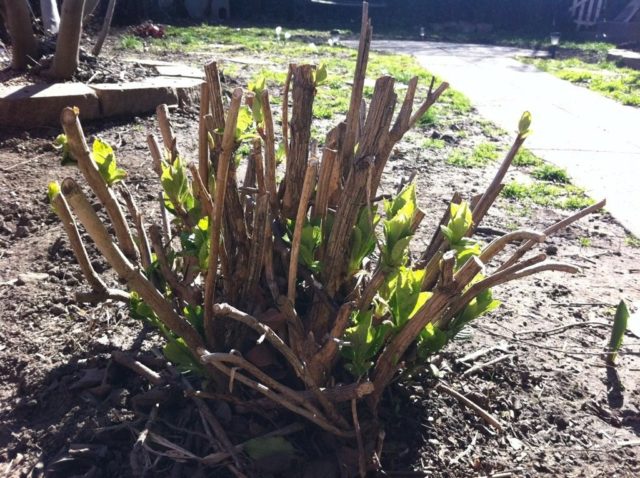
In the spring, except for the removal of non-wintered shoots, all last year's are shortened to the lowest bud
Sanitary pruning is done in the fall. It is part of preparing the plant for winter.
Preparing for winter
At the end of autumn, the plant is sanitized, damaged and too old shoots are removed from it. After that, water-charging irrigation is done and the trunk circle is mulched with a layer of straw, sawdust or fallen leaves up to 20 cm high. In the case of a particularly cold climate, the protective layer is covered with a film or agrofibre on top.
Reproduction
Rough hydrangea reproduces in all available ways:
- seeds;
- cuttings;
- layering;
- dividing the bush.
Unlike many ornamental crops, seed propagation of rough hydrangea is used quite often, since plants grown in this way begin to bloom relatively early.
The most effective method of propagation, which gives the maximum amount of planting material, is by cuttings. They are obtained from side branches.
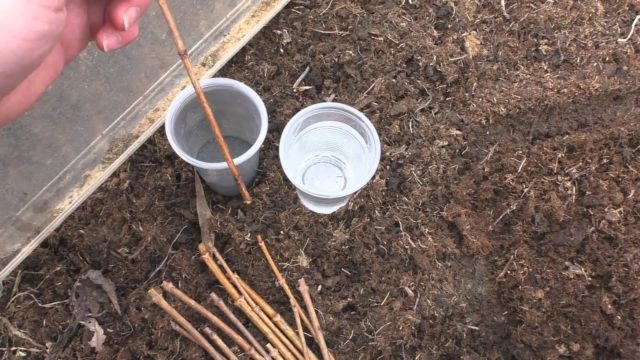
The length of the cutting should be at least 15 cm, and only one bud is enough on it
Rooting is carried out in a substrate consisting of peat and sand for a month. The soil must be kept moist. As soon as the cutting reaches a length of 30-40 cm, it is transplanted to a permanent place.
Diseases and pests
The immunity of the rough hydrangea is very high. The plant is rarely affected by diseases and pests. If this happens, then the reason is likely to be improper agricultural technology.
The most common problem in rough hydrangea is leaf chlorosis. In this case, the color of the plates begins to change to yellow, but the veins always remain green.
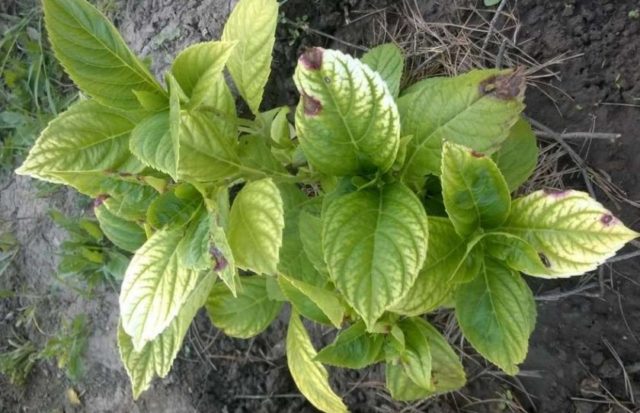
Over time, the leaves become covered with dark brown or brown spots, later on, holes appear in their place.
Iron deficiency is the cause of the disease. For treatment, the damaged areas should be removed, and the remaining parts of the plant should be treated with a 4.5% solution of ferrous sulfate.
In second place in terms of frequency of occurrence is the well-known powdery mildew - a disease caused by fungi of the Erisyphus family.
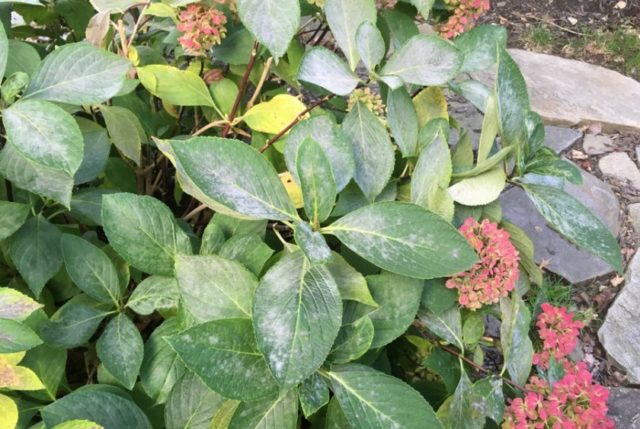
Pale gray spots appear on the leaves, which darken over time.
To combat powdery mildew, various drugs are used (Bordeaux mixture, copper sulfate, sodium carbonate, etc.), but for rough hydrangea, Fundazol is the best remedy. It is used 3-4 times, spraying whole plants at intervals of 1 week.
Of the pests, the rough hydrangea is most often attacked by a spider mite - a small representative of arthropods that feeds on plant sap. It is less than a millimeter in size and is sometimes problematic to detect.
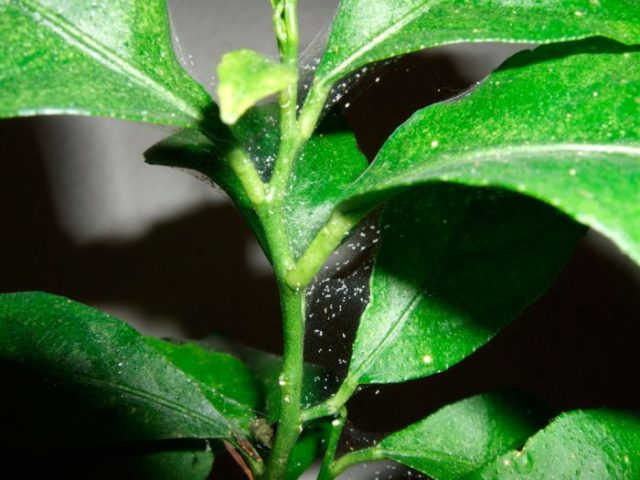
The symptomatology of a tick lesion is very characteristic - cobwebs with small white dots appear on the lower part of the leaves.
The best remedy against this pest is powerful acaricides: Actellik, Askarin, Iskra.
Conclusion
Rough hydrangea is a beautiful plant with a wide variety of colors and shapes. Besides the beautiful flowers, the large leaves that change color at the end of the season are also very decorative. The plant is widely used in landscape design.
Reviews of hydrangea rough
